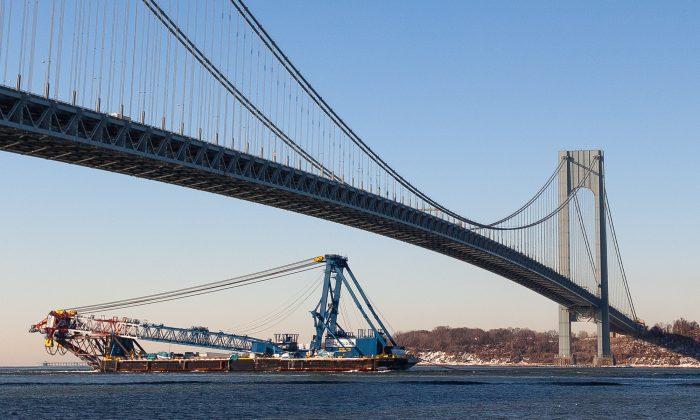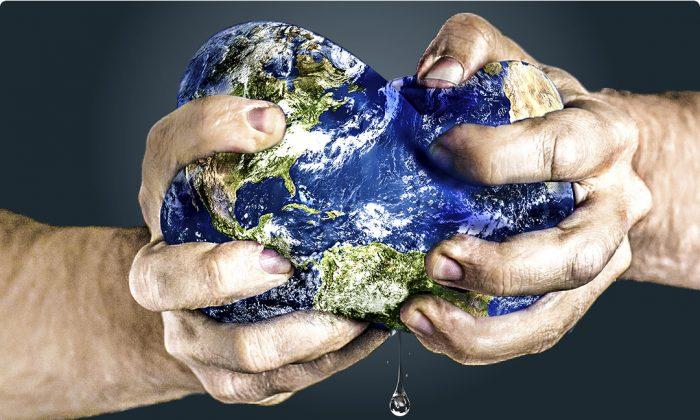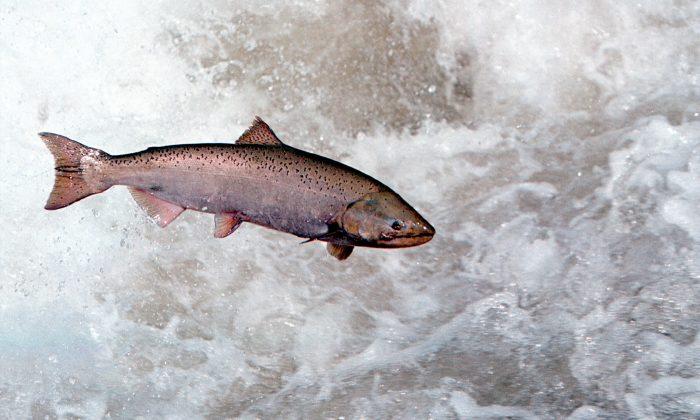JERSEY CITY, N.J.—One of the largest cranes in the world arrived in New York Harbor Thursday morning, ending a six-week, 6,000-mile trip over water that included a pass through the Panama Canal. For Jim Daley, though, it was all in a day’s work.
Daley is director of operations for Foss Maritime, the Seattle-based company whose tugboats escorted the rudderless, engineless barge carrying the so-named I Lift NY Super Crane.
The crane is part of Tappan Zee Constructors’ $3.12 billion package to build the new Tappan Zee Bridge just north of New York City. It was custom-designed and built for the project.
“We’ve taken bigger and we’ve taken smaller,” said Daley at Weeks Marine in Jersey City Thursday, where the crane will stay docked until spring. Around late March or early April, different tugs will take it the final 25 miles up the Hudson River to the project site.
The company, which started in 1889 in Tacoma, Wash., with a Norwegian immigrant and her husband and a single rowboat, is now a global operation. For Daley, who is responsible for managing all boats that go out of harbor, that means keeping tabs on the Foss network of vessels and their status—whether at work, docked, or awaiting the next job.
“My job is 24/7; I have people all over the world,” he said, ticking off countries such as South Korea, Canada, Haiti, and the city of Abu Dhabi. They aren’t all work boats, either. In Washington state’s Neah Bay, a rescue harbor boat is on standby at all times.
Tugboat Escorts
The two Foss tugboats that escorted the crane, the Iver and the Lauren, set off from Oakland around the end of December, shuttled the crane down the west coast of the Americas, through the Panama Canal, and up the Eastern seaboard. Daley, who grew up in Harlem and has worked in the maritime industry for 36 years, said it was smooth sailing all the way. In the end, the smaller of the two tugboats, the Iver, was hardly needed for the trip.
“What we actually ended up doing is drawing the Iver along,” he said. Daley said a rough estimate of the cost of the transport project, which has been in the works since last summer, is about $2.5 million, though he wouldn’t give an exact figure.
But the larger Lauren, which carries 224,000 gallons of fuel, did some serious pulling.
Even partly disassembled, about 60 feet of the I Lift NY Super Crane’s 328-foot boom overhung the barge. As the tugboats brought the crane and barge in Thursday morning, the steel construction seemed to dwarf Manhattan’s skyline in the distance. Many mechanical pieces were shrink-wrapped in plastic for the journey to protect them from seawater, and it will be reassembled in the coming weeks before it is transported to the Tappan Zee Bridge construction site.
Once there, it will play a key role in the bridge’s completion, which is scheduled for 2018.
“It allows us to do the bridge construction safer and in a shorter amount of time,” said Carla Julian, community outreach and diversity manager for Tappan Zee Constructors. For example, said Julian, it can lift modular, pre-assembled pieces that weigh between 900 and 1100 tons.
Brian Conybeare, a special adviser to the governor for New York State Thruway, said the faster, the better, as it is “such an important part of the infrastructure for the state and the nation.”
As for the tugboats, their journey with the crane is now over. They, and their crews of about seven people each, will be in the area for just 48 hours before moving on to other jobs. The Iver will head back to Seattle, and the Lauren will go to Philadelphia to pick up the naval carrier the USS Forrestal and deliver it to Brownsville, Texas, for scrap metal.
Lauren’s captain, Dwaine Whitney, won’t get a chance to see New York City or go to the Super Bowl, but there are other perks to his job that keep things interesting, like towing the USS Forrestal.
“It’s not very often that you get to tow something that’s 1,000 feet long and a part of history,” said Whitney. “That gives you an idea of what these boats are capable of.”





Friends Read Free